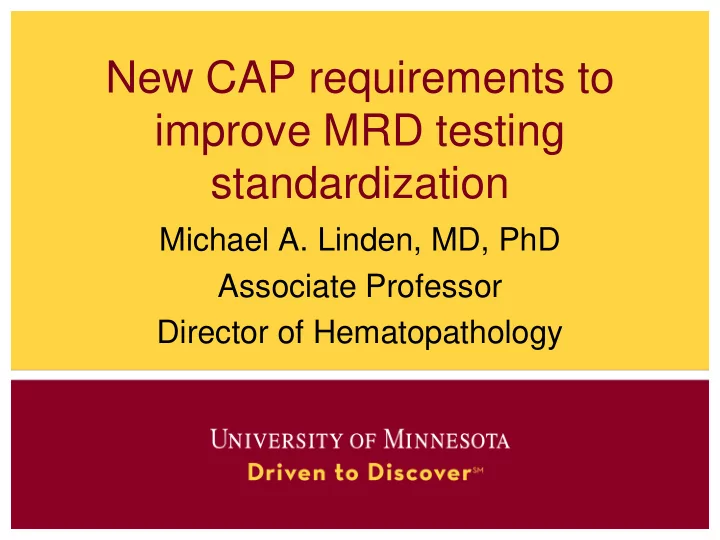

New CAP requirements to improve MRD testing standardization Michael A. Linden, MD, PhD Associate Professor Director of Hematopathology
Disclosures • Vice-Chair, Diagnostic Immunology Resource Committee, College of American Pathologists • Council Member, International Clinical Cytometry Society • I receive royalties from Cell Signaling Technology, Danvers, MA, who uses technology that I created to produce monoclonal antibodies
College of American Pathologists • Accreditation program – 7600 labs worldwide, through Checklists and peer inspections • Proficiency testing/external quality assurance program – more than 20,000 labs worldwide subscribe to Surveys
Diagnostic Immunology Resource Committee • Serve as CAP’s scientific and educational resource for diagnostic immunology and flow cytometry • Multiple “dry” and “wet” proficiency testing Surveys
Hypothetical clinical encounter • A patient with a history of plasma cell myeloma undergoes bone marrow biopsy at institution A • The patient has a close family member who works at reference lab B • The bone marrow aspirate is split and sent to both labs A and B for MRD testing
Flow cytometry lab A • Your patient’s bone marrow biopsy is POSITIVE for minimal residual disease
Flow cytometry lab B • Your patient’s bone marrow biopsy is NEGATIVE for minimal residual disease
You call down to the lab and ask the pathologist… • Why are the results discordant? • What are the next steps?
Some factors affecting MRD limit of detection • Patchy disease • Aspirate hemodilution • Staining method (including lysis) • Number of “colors”/antigens studied • Number of events collected
Number of events collected 380,000/45 affects sensitivity 200,000/17 50,000/3
Major heterogeneity in PCM flow testing
College of American Pathologists (CAP) MRD Survey • Approximately 550 labs subscribe to our flow cytometry proficiency testing Survey (wet challenge) • In 2014 we surveyed all labs to ask if they perform MRD analysis; we had 91% of labs complete the survey • 91 labs (18% of respondents) perform MRD for myeloma • These labs are worldwide, but predominantly in North America
Limit of detection (LOD) • Survey was designed to ask about what the labs perceived (or measured) analytical LOD was for myeloma MRD • We did not ask about number of events collected, number of “colors,” etc. • Choices included 0.1%, 0.01%, 0.001%, and other
Reported LOD among 91 labs that perform MRD testing for myeloma Plasma cell myeloma While some labs 60 report an LOD 50 lower than 0.001%, some 40 labs report their 30 LOD as high as 1%! 20 10 0 0.10% 0.01% 0.001% Other Arch Pathol Lab Med—Vol 139, October 2015
New changes for CAP Checklist • Two new Checklist items created to specifically address rare event flow cytometric analysis/MRD • Goal is to help clinicians and pathologists compare results from different labs and ultimately improve standardization
New Checklist Items
Example dilutional experiment • Bone marrow sample has a plasma cell clone comprising 10% of leukocytes. • 10 fold dilutions would be made into normal marrow so that the expected recovery would be 1%, 0.1%, 0.01%, 0.001% and 0.0001% • All samples stained and run in parallel to find out limit of detection
Hypothetical scenario revisited • A patient with a history of plasma cell myeloma undergoes bone marrow biopsy at institution A • The patient has a close family member who works at reference lab B • The bone marrow aspirate is split and sent to both labs A and B for MRD testing
Flow cytometry lab A • Your patient’s bone marrow biopsy is POSITIVE for minimal residual disease ( the measured and reported lower limit of detection for this lab’s PCM MRD assay is 0.001%)
Flow cytometry lab B • Your patient’s bone marrow biopsy is NEGATIVE for minimal residual disease ( the measured and reported lower limit of detection for this lab’s PCM MRD assay is 0.01%)
Questions now answered by the provider • Why are the results discordant? Lab A has a more sensitive method than Lab B • What are the next steps? Varies, but the main thing to remember is that: – Lab A ≠ Lab B
Summary • There is major heterogeneity in how the labs surveyed define MRD for PCM by flow cytometry • Leukemia/lymphoma and MRD testing by flow cytometry are laboratory developed tests • National and international professional organizations, as well as market pressures, will continue to encourage the field to standardize/improve
QUESTIONS? LINDE013@UMN.EDU
Recommend
More recommend